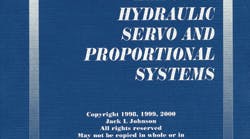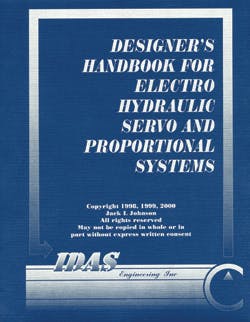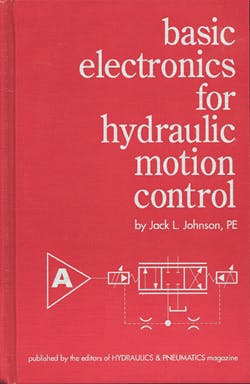System design normally calls for a specific load to be overcome and propelled at some required velocity. This is called the design point or design target. A further reality is that most machines are required to operate at an essentially unlimited number of operating conditions as the actuator accelerates, decelerates, and stops. When the system is designed, the design point must accommodate the absolute worst-case operating point expected over the entire lifetime of the machine.
The designer must investigate all possible operating conditions and determine the worst case. This, in many systems, is the operating point that requires the greatest amount of power to the load. Furthermore, this worst-case condition may occur only when the cylinder is extending, or it may occur only when it is retracting.
Evaluating the calculations
Design in the context of this discussion means the proper sizing of the hydraulic system to meet the application’s requirements. In the graphical sense it means that the designer must adjust the operating envelope so that the worst-case operating point is within the operating envelope. All other operating conditions must then lie within the operating envelope.
The operating envelope is adjusted by selecting the right combination of supply pressure, PS, cylinder size, APE, and valve size, KVPL. But there is a dilemma: only one operating point is specified as the design target and only one equation (the VCCM equation) exists, but there are three unknowns.
An infinite number of possible solutions to the VCCM equation exists. This is where the concept of maximum power transferis applied, which creates a second operating point to be met. Now we can set up two equations with three unknowns, which is a bit more manageable. When the designer uses the maximum power transfer theorem, the resulting system is said to be optimally designedand produces the best control.
Given that two equations and three unknowns now exist, an infinite number of solutions likewise exists. However, all three parameters must represent realistic industrial situations. When the servo or proportional system is designed, typically some knowledge of or constraints upon the system pressure exists. Indeed, for every system I have designed, the pressure was predetermined by factors beyond my control. This is a delightful scenario because we now have two equations and two unknowns, and we can simultaneously solve for the very best valve and the very best cylinder to achieve our design goals!
A practical example
Suppose we establish a design goal in which the worst case conditions require 42,100 lb of force at a speed of 11.5 in./sec. Further suppose that we must use an existing power unit that delivers a regulated output pressure of 3400 psi. Without belaboring the mathematics, the formula for the optimal sizing of this cylinder is:
APE = 1.5 fL,DP ÷ PS,
where APE is the powered end area in in.2 (which could be either the cap end area or the rod end annular area, depending on whether the cylinder is extending or retracting),
fL,DP is the required design point load force, in lb, that must be generated at the cylinder rod at the specified design point velocity, and
PS is the supply pressure, in psi, (the pressure at the P port of the valve. In this example, it was specified as 3400 psi).
The optimal valve size is:
KVPL = √2APE3VDP2÷fL,DP (1+ρv3/ρc2),
where VDP is the required output speed at the design point, in in./sec; it has no units,
ρV is the valve ratio, which is selected now, at design time; it has no units. We’ll use an off-the-shelf valve, and, therefore, expect symmetry, meaning that the valve ratio is 1, and
ρC is the cylinder area ratio, which presents another mathematical dilemma. We need to know the cylinder ratio before we can select the cylinder, and how can we know it if the cylinder has not yet been selected?
Two possibilities exist. First, we could select the cylinder, because the first equation calculates the powered end area. That’s enough information to go shopping for a real industrial cylinder. We would also know the area ratio if we also selected a standard sized rod. The second possibility is to estimate, or anticipate, what a typical valuemight be, then defer the actual cylinder selection until after the valve coefficient has been calculated.
Most industrial cylinders have extending area ratios between about 1.3 and 1.5. As a first guess, 1.33333 (4÷3) is good, because cylinders with a 2:1 bore-to-rod diameter ratio all have an area ratio of 1.33333.
Finally, KVPL is the valve coefficient of the powered land in in.3/√psi. Once the valve coefficient has been calculated, valve shopping can begin. I emphasize that the calculated value from the previous equation will yield the optimal valve size, but a real valve may be somewhat different. The designer must select a valve with a coefficient that is sufficiently close to the optimal value.
For the example problem presented earlier, when the optimal area and valve coefficient have been calculated, the values are:
APE = 18.575 in.2 and
KVPL = 7.57 in.3/√psi.
The optimal cylinder area corresponds to a bore of 4.863 in., so we would use the next higher standard bore cylinder, which is 5 in. The valve coefficient must be converted to rated flow. The value for rated flow depends on whether a servovalve or proportional valve will
be used.
Servovalves are flow-rated at 7 MPa, or 1015 psi, according to the latest ISO standard on the subject, ISO/10770-1. This means that each land of a symmetrical servovalve will undergo 507.5 psid pressure drop. Proportional valves, on the other hand, are flow-rated at 1 Mpa, or about 145 psi for the entire valve, or 57.5 psid for one land when the valve is symmetrical. The rated flow is calculated from the basic orifice formula:
Qr = KVPL × ∆PQr
where KVPL is the value just calculated for the valve coefficient,
∆P is the flow rating pressure (either 507.5 psid for servovalves or 57.5 psid for proportional valves),
and Qr is the rated flow of the valve and represents the value we must obtain as listed in valve catalogs. Be aware that the native units work out to in.3/sec and must be converted to gpm in most U. S. catalogs. For our example, the rated flow calculated for the optimal servovalve is 44.3 gpm. For a proportional valve, the rated flow would be 16.7 gpm.
If we use a real industrial cylinder, it has a slightly bigger bore than the optimal cylinder. So we must be concerned that the valve, at 44.3 gpm, might be too small to attain the target speed of 11.5 in./sec at a supply pressure of 3400 psi. We can manipulate the VCCM equation to check the situation, but now, knowing the speed, load force, cylinder area (5 in. bore, 19.635 in.2) and supply pressure:
KVPL= (vDP2×APE3) ÷ (PSAPE– fL,DP)
where all values are known (we’ll use a 21⁄2-in. rod diameter, to stay with the 4:3 area ratio). The new valve coefficient becomes:
KVPL = 7.6 in.3/√psi
For servovalves, Qr = 44.5 gpm; for proportional valves, Qr = 16.8 gpm.
As a summarizing statement, note that there was no stipulation as to whether this load is to be moved while the cylinder is extending or retracting. However, the problem has been solved under the assumption that the cylinder would be extending. The key value is the assumed cylinder ratio (4÷3), which, by definition, is extending.
Different scenarios
Suppose we had to design the system with the load and speed values while the cylinder was retracting. The exact same formulas could be used. However, the cylinder ratio would be inverted, to 3÷4, and the calculated area would be the annular, rod-end area. In the interest of space, that situation will not be evaluated here.
Many more situations and scenarios can be investigated by manipulating the VCCM equation but will not be explored here. For example, we may desire a sub-optimal design strategy that produces lower pressure drop at the design point, or that uses a non-symmetrical (valve ratio does not equal one).
Some interesting performance enhancements can come from non-symmetrical valve ratios. One very important one is that large over-running loads can be accommodated without cavitation and without any sacrifice in control or efficiency.
My intent has been to introduce the power and flexibility of having valve coefficients for our valves instead of the conventional industry practice of publishing the rated flow. KVis a property of the valve. Each land or orifice in the valve has a KVvalue, even when the valve is sitting on the shelf. Rated flow, on the other hand, is something that the valve exhibits only when it is operated at precisely the flow rating pressure of the valve.
In the real world, this essentially never happens. Contributing to confusion are the two different standard flow rating pressures — one for servovalves and one for proportional valves. When we know the valve coefficient, we can calculate the flow under any conditions, not just at rated pressure.
Handbook serves electrohydraulic system designers
The fourth edition of the Designers’ Handbook for Electrohydraulic Servo and P
• how to calculate and control pressure losses in plumbing, subplates, and manifolds,
• how to analyze and control a variety of mechanical loads, including conveyors and belts and triangulated loads,
• valve dynamic properties and how to include them in your system,
• electronics, especially transducers and signal conditioning, and
• mobile equipment electrical systems, including batteries and charging systems.
The textbook contains 786 pages and sells for $159. To order, visit our Bookstore. Print the PDF order form, fill it out, and mail, fax, or e-mail it to us.
Buy the Designers’ Handbook for Electrohydraulic Servo and Proportional Systems and get a copy of Basic Electronics for Hydraulic Motion Control for free. It contains extensive coverage of electronic feedback and control, with emphasis on hydraulics technology. This hardbound text is a must for anyone considering certification as a fluid power engineer.



